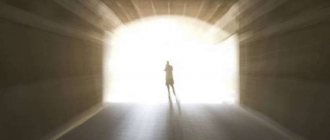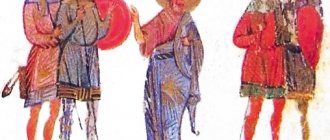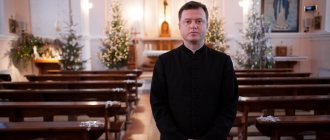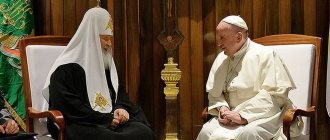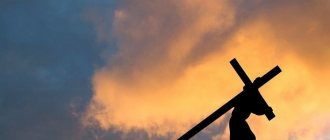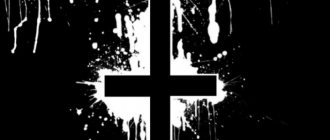Cross at the feet, crucifix facing the deceased
Although there is still debate, most Russian Orthodox priests agree that there is no fundamental difference in where the cross should be installed. The main meaning of a cross on a grave is to indicate that a Christian is buried in the grave. Therefore, none of the options is heresy, and the cross is often placed according to local traditions.
More often in Rus' they place a cross at the feet of the crucifix in the direction of the deceased.
FUNERAL ORGANIZATION
ACCORDING TO THE ORTHODOX RITE
More details
How to install
Immediately after burial, a crucifix with the name of the deceased and dates indicating the dates of his life is placed on the grave. It stands until relatives erect a permanent monument. The installation of the monument cannot be done immediately after the burial, since the soil on the grave is loose and installation of the structure will be difficult.
According to church laws, you need to install a wooden product and not change anything on the grave for up to 40 days. On the 40th day, the deceased will go to the Lord's Judgment, climbing Golgotha and carrying his cross. Relatives should make sure that it is not difficult for him to carry his burden.
After 40 days have passed, a metal symbol or monument can be erected. It’s better to wait 6-12 months - during this time the soil on the grave will settle and you can erect a monument without much difficulty. But you need to choose the right time - the most favorable period is considered to be from March to September. The differences in attitude between Orthodox and Catholics are insignificant.
For Orthodox
Relatives consider it their duty to do everything so that the deceased finds peace in the world of the dead. As a result, monuments appear on graves. They do not carry the meaning of faith, but to a greater extent are established only from the ethical side. The monument is placed at the feet of the deceased, placed in front of the cross a year or more later, when the earth has settled.
A previously installed crucifix can be removed, but most still leave it. This is due to the absence of an image of a cross on the monument. If it is not on the slab, then the cross-shaped symbol must remain behind it at all times. It is painted periodically to prevent the wood from drying out. The tombstone must necessarily depict the faces of the Saints, the dates of life of the deceased and his photo.
For Catholics
Catholics also place crosses on graves, but unlike Orthodoxy, these are always four-pointed structures. There is no photo of the deceased on the crosses; only the dates of birth and rest are stamped. Photos on Catholic tombstones can be found in Eastern European countries, as a tribute to the unity of the socialist community, for example, among Armenians and Germans. The decor may include engravings in the form of the Virgin Mary, Angel, Jesus Christ. There are also additional elements that fasten ropes, ribbons, and branches of roses with thorns.
Catholic monuments are made in the form of sarcophagi, crypts or monuments with statues of the Madonna and other saints. This tradition has reached its contemporaries, but differs in scale - you rarely see a huge structure on a grave; monuments have become more modest in size.
Catholics often place crucifixes in the head of the deceased. For him, this is the banner that he will carry during the Last Judgment. Monuments, just like crosses, must be placed in the head of the deceased. There must be a four-pointed symbol at the top of the slab. And in the lower part there is a rectangular flower bed.
The cross at the feet as a spiritual support
In this case, the cross carries the symbolic meaning of spiritual support and eternal life. When, in accordance with Christian dogmas, the resurrection of the dead occurs, the first thing that the deceased will see on the day of the Last Judgment will be the sacred symbol of the crucifixion. Another reason for placing a cross at the foot of the grave is that when the Resurrection occurs, those who rise from the grave will be able to lean on it. Thus, the cross acts as a source of light for the soul and support for the body.
The custom of placing a cross at the head of the head is more common among Catholics and Orthodox Christians living in European countries. This arrangement personifies the victory of the Savior over the devil. Some believe that, having been resurrected, a dead Christian will carry the cross as a banner.
You might be interested:
- Temples in Moscow cemeteries
- How Old Believers are buried
- A note in the church about repose - how to write and when
November 7, 2018
Which cross is better to choose
Immediately after the funeral, it would be correct to put up a temporary cross made of wood: pine or maple. A metal type or monument can be installed six months to a year after the funeral. For 40 days, it is generally prohibited to do anything at the grave.
Materials
A permanent product can be made of metal or hard wood. Before making a decision, it is recommended to study what their differences and advantages are.
Made of wood
Wooden varieties are placed on the grave by true adherents of Russian traditions. Such crosses have been erected since ancient times, believing that wood is a receptacle of divine power. In order for the product to last as long as possible, it is necessary to choose hard types of wood: oak or pine.
Design is of no small importance. There are several options popular among Orthodox Christians:
- Carved ornaments in the form of vines or thorns. The vine symbolizes the connection of the soul of the deceased with the Lord.
- Make an inscription or abbreviation.
- Make a domino - the parts are crossed with upper crossbars, forming a roof.
- Carved or superimposed figures of the Savior.
- Hang an icon patronizing the deceased.
No matter how strong a tree is, it has the ability to collapse.
Therefore, it is necessary to constantly look after it, and this does not always work out. In this regard, you can increasingly see crosses made of metal on graves. Temporary wooden crucifixes, when replacing them with permanent ones, are generally recommended to be burned in a cemetery, in a designated place or in a church oven. You cannot throw it away, as this shows disrespect for the deceased. If a decision has been made to erect a monument, it is recommended to leave the cross nearby or lean it against the fence. However, he cannot be kept in a lying position on the grave for a long time.
If you feel bad about burning a wooden temporary cross, there are also many other ways to dispose of it.
Made of metal
If you want the product to be reliable and last a long time, you need to choose metal. It will last much longer than a similar cross made of any type of wood. Metal varieties are divided into forged and welded types.
Welded ones are the cheapest, costing less than a carved wooden cross. They are made from profile pipes. There are very few decorative details on this model.
Forged - made by hand, very beautiful and much more expensive. The base of the cross is made of stainless steel, and the decorative parts are made of copper, brass, bronze and other alloys.
Forged types have different shapes. These can be Orthodox eight-pointed models, Catholic, Greek, Burgundian and others.
About the form
When considering the types of crucifixes, it is impossible not to mention the features of the form. Currently the following types are distinguished:
- Four-pointed is an ancient type, dating back to the times of the early Christian church that existed before the schism. In the modern world, Orthodox Christians rarely erect such crucifixes. They can be seen among Catholics and Protestants. It can be placed on the grave of a person who did not identify himself with any denomination.
- Six-pointed is the most common variety. Presented in the form of a traditional cross and a transverse oblique crossbar underneath it. It is rare to see a form where the extra crossbar is placed on top of the cross and straight. This variety is “universal” - you can find it on the graves of Orthodox and Catholics.
- The eight-pointed one is an ancient type of Orthodox cross, along with the four-pointed one, which existed even before the split between Orthodox and Catholics. This type is installed on church domes and on the graves of true believers. Ordinary believers consider this model of the cross to be too pretentious and rarely use it.
When choosing a crucifix, one should be guided by the faith of the deceased. His will should not be violated if it was declared before death.
Metal
A metal cross in a similar way. Just like wood, iron must be treated with alkyd or other paint that protects the metal from corrosion. If there are unpainted areas left, moisture will cause the cross to become covered with rust, lose its aesthetic appearance, and its service life will be significantly reduced.
Concrete mortar is better suited for installing metal products. It fills all the voids in the pit and, after hardening, does not shrink the soil and is resistant to changes in temperature and humidity.
Before pouring concrete, it is recommended to place the cross in a hole, set it level and hammer it 10 cm into the ground. Then pour the concrete and wait for it to dry completely. Then you can fill the hole without waiting for rain.
The Christian cross was preceded by the Egyptian ankh - a symbol of eternal life
The cross-sun passed into different religious traditions. After all, the experience of our ancestors has not disappeared. Ancient Egypt has preserved for us a more transcendental view of the cross than was probably originally attributed to it.
The gothic subculture widely disseminated the "ankh" symbol. Perhaps everyone saw him today. But we are interested in what the ancient Egyptians saw in the ankh - a symbol of eternal life, a promise that the soul does not disappear after death, but passes into a different state in the afterlife.
The Ankh is a symbol of eternal life even before the Christian cross. Photo: salik.biz
We will not dwell in detail on Egyptian beliefs. Let’s just say that the ankh looks even more like the figure of a man with outstretched arms - due to the loop at the top of the symbol.
It is the connection of the cross with afterlife symbolism that is the thread that closely connects the most ancient beliefs with modern Christianity.
There is no need to be afraid of this. This does not mean at all that Christianity is some kind of secondary religion.
We just have to understand that nothing comes out of nowhere.
Theological thoughts, images, spiritual experience - all this is rethought and supplemented by new traditions, but internal knowledge of the divine has always accompanied humanity, including in pre-Christian eras.
After all, was Noah a Christian? Of course not. But this did not stop him from being a pious and believing person.
For ancient people, the cross is a symbol of the sun and God
The cross became established in astrology during the Neolithic era. He was depicted in the center of a circle, which served to symbolize the sun.
We don't need to be afraid of astrology. Orthodoxy actively criticizes various newspaper fortune tellers and charlatans who publish “star forecasts for the coming week.” But ancient astrology and astronomy are a completely different science.
Then there was no gap between religion and the study of the sky, everything was connected, and every person understood that the stars are a projection of divine energy into our world.
The solar cross - since ancient times, this symbol has been revered by people in different variations. It lies at the heart of the Christian cross. Photo: upload.wikimedia.org
Accordingly, they monitored the sky, made forecasts based on observations, calculated calendars, set dates for holidays, and oriented crops based on the celestial bodies. And the survival of a person who began to master agriculture depended on this.
The sun is a giver of warmth and light and an expression of God’s care, which means that through it you can direct your gratitude to the Almighty. So it makes sense to talk not about the cult of the sun, but the sun as a connecting element of the earthly and divine. The cross is a symbol, a place of fusion of matter and spirit, a door to the other world.
Today's astronomers have established this symbol for the earth, but we know that initially everything was not so.
The cross became a symbol of eternal life long before Christianity
In general, crosses as a religious symbol are not an invention of Christianity. This is one of the simplest images that could ever come to a person's mind.
It is not surprising that cruciform images have been found on almost all continents since the ancient times of the Neolithic and Paleolithic.
The meaning of these images is clearly religious, for many of them were made in difficult-to-reach cave spaces and at high altitudes. Obviously, people painted such images not for entertainment, but with a sacred meaning.
People have depicted crosses since ancient times and invested them with sacred meaning.
There is no consensus among religious scholars and historians about what the cross meant for our distant ancestors. There is, for example, an opinion that an x-shaped cross is the simplest image of a person.
But in observable history, the cross is already astrological, mystical and religious symbol. Let's talk about this further.
Installation of a granite cross
The main difficulty in working with a granite tombstone is its large mass. You will have to be especially careful when mounting a cross made of granite, since it is also difficult to align it vertically. Fastenings for a granite grave cross are installed during manufacturing, but they are different.
Typically, metal reinforcement is screwed along the length and width of the base. The structure with the base is lowered into the ground and then buried. Thanks to its solid weight, the structure will be stable, will not tilt or fall.
Installation as a whole does not require any special skills; everything is done simply and does not take long. Granite is a natural stone, created by nature, so it is not subject to atmospheric influences and does not need to be further processed. If the tombstone is made of crumbs, you will have to treat it with an antifungal solution and moisture-proofing agents so that moss does not appear on the base.
Wood
If the cross is made independently, then it is necessary to pay attention to the correct selection of the type of wood, as well as its careful preparation and processing.
Since wood is not a durable material and is highly dependent on humidity, it is better to choose coniferous wood or give preference to oak. In the first case, nature impregnated the wood with pine resins, protecting it from all weather conditions. As for oak, this strong tree is quite resistant to moisture and will last in the ground for a long time.
After it is made, it must be carefully treated with impregnations or varnishes, which will protect the wood from parasites, fungus and moisture, and also give it an aesthetic appearance.
Now you can start installation. To securely fix the cross in the ground, you can use two methods. The first involves filling the hole with cement mortar. In the second method, support beams are attached to the base of the cross, with the help of which it will be held in the ground.
To do this, you need to make two pairs of legs, and attach them at the very bottom of the base and a little higher - shallow from the surface of the earth. The legs need to be fastened both horizontally and vertically.
Then it, together with the supporting legs, is placed in a hole, the width and depth of which must correspond to the dimensions of the cross itself, otherwise it will lead and it may tilt or fall. When installing, you need to try to secure the base in the ground as firmly and reliably as possible.
Since the soil tends to sag, it is better to use clay when filling the hole. It will set, will not allow moisture to pass through, will not sag, and will not be washed out by rain. Then, after some time, when the rains come and the soil settles, it will be necessary to fill the hole. If there is no rain, you will need to wait.
Why do people bury their heads to the west and their faces to the east?
Orthodox Christians are buried in the cardinal directions according to the traditions of a given society. Sometimes the will of the deceased is fulfilled. Christian believers are placed with their heads to the west, respectively, their face is turned to the east. This is due to the belief that a deceased person has acquired eternal life, and the sunrise represents the beginning of a new day and a new life. The head to the West is a symbol of the end of earthly life, and the face to the East is the beginning of a new heavenly life.
The correct location of the coffin in the grave is also determined by silent prayer. Prayer will preserve the life of the resurrected soul in the event of the end of the world. So, when it comes, Jesus will come from the East, and according to legend, Paradise is located there. His arrival must be accompanied by a meeting with the resurrected dead face to face. Therefore, churches are built in such a way that parishioners look to the East during prayer - to the Face of Jesus Christ.
If, due to ignorance or other reasons, the deceased was buried with his head facing east, then this is a great sin. His burdens will fall on the shoulders of his relatives. You need to consult with a priest, pray in church and ask him for advice on what to do next. With the permission of the church and authorities, the deceased can be shifted correctly.
The burial must also take place in accordance with the requirements of the Orthodox faith. It is important to follow the sequence here:
- As soon as a person dies, he must be washed with warm water. Sponges are used in the process, and washing is done by elderly citizens who are not relatives of the deceased.
- It is important to say a prayer while washing.
- Upon completion, it is necessary to put clean clothes and a pectoral cross on the deceased. Clothing is chosen with the expectation that he will be buried in it.
- The coffin is sprinkled with holy water before the body of the deceased person is placed in it.
- The body is placed in a coffin, hands folded on top of each other. An important condition is to place your right hand on your left.
- An icon is placed on the chest, and a crown is placed on the forehead, which can be received after the funeral service in the church.
- The deceased must be covered up to the chest with a sacred carpet.
- The coffin is placed with its feet facing the exit. You need to light candles and a lamp at the head. Until the coffin leaves the room, they must burn.
In the church, after the funeral service, everyone asks the deceased for forgiveness, kissing the aureole and icon. Then the body is completely covered with a shroud and the priest intersects it, covering it with earth in a cross shape and reciting prayers.
Compliance with the burial ritual is not necessary for the deceased, but for the surviving relatives. A properly conducted funeral will soothe the souls of loved ones and bring peace and relief. Relatives should also pray for the soul of the deceased, making his afterlife easier, praying for forgiveness before the Lord.
Where on the monument should the cross be placed?
A religious symbol can be placed in different ways. If the monument is double, for example, for spouses, then the cross is logically placed in the space between their photographs. If the monument is single, then engraving can be done in the corner of the stele or on its back side.
You can order a monument in Grodno and other regions from our company - contact our manager and tell us your wishes. We are engaged in the production of tombstones, cemetery sculptures and fences, as well as the decoration of monuments.
The cross became a symbol of Christianity back in the 1st century
And now we come to the Christian era. At the beginning of our era, the Roman Empire firmly held influence over all of Europe, part of Asia and Africa. The orders of the ancient world spread to other states.
Methods of execution were no exception. One of them is the crucifixion. But one should not think that the Romans deliberately took a religious symbol and decided to desecrate it by killing criminals.
They simply selected the simplest and most effective designs for execution. Known are x-shaped crosses, tools in the shape of the letter “T”, pillars and the cross that would later become a symbol of Christianity.
Although the cross was a religious symbol for many peoples, a number of ancient states used it as an instrument of execution. Christ was executed according to ancient rules - just like the two criminals on each side of Him (Andrea del Castagno, “The Crucifixion”). Photo: artchive.ru
It fell to Jesus Christ to die on the cross, and here one can discern direct divine providence and symbolism. It is no coincidence that the Son of God dies on the most ancient symbol, as if announcing to all people that they are blind and do not see the obvious - the coming of the Messiah.
But already on the third day the Savior was resurrected, so His disciples clearly could no longer perceive the cross as something destructive.
But there is an alternative version, according to which the first Christians used fish and other symbols as their symbol, but already in Pompeii an image of a cross was found (Herculaneum Altar), possibly bearing a religious meaning.
For us, this may mean that already in 79 Christians revered the cross. However, this is a rather controversial statement, which has nothing to counter with captious criticism.
The Herculaneum altar in Pompeii in various stages of destruction. At the top you can see something similar to a cross. This could be evidence of the veneration of the cross by Christians in the 1st century, but most likely it was some kind of fastener, which skeptics insist on. Photo: 3.bp.blogspot.com

